The functioning of our universe and atomic is based on the oscillation of the particle itself and asymmetrically between matter and antimatter. This mechanism is a classical an-.harmonic oscillator and uses a linear oscillation of the particle, where the energy can be represented by the graph of a potential well. In this potential well the alternation followed by the principle of energies ocursy conservation between the kinetic energy and potential energy. This an-harmonic oscillation of the particle thus therefore occurs through awith an gravitational oscillator (see "hole through the Eearth simple harmonic motion"), followed by an singularity avoidance. Indeed the important kinetics of the particle leads to an singularity avoidance to pass oover the supermassive black hole to plot the Higgs field/potential. The alternation of the particle at very high frequency generates by the principle of mass-energy equivalence in vacuum (E=mc²) a mass flux expressed by the quantum fluctuation determined by a scalar energy density. This scalar density represents for example the dark matter and the residues of the latter in the quantum vacuum. However a vectorial interpretation of the particle is possible as soon as its oscillation through the oscillator is really minimized before becoming a mass-energy equivalence flux. That represent the elements related to Einstein's Stress Energy Tensor. Here is the one of interpretation of quantum mechanics in relation to relativistic physics.
- anharmonic oscillator
- singularity avoidance
- gravitational oscillator
- oscillating universe theory
- oscillating model
- cyclic model
- Higgs
- universe
- theory
- kartazion
- oscillating Universe
1. Introduction
 Figure 1. Once Upon a Time the Universe: Anharmonic Oscillator.
Figure 1. Once Upon a Time the Universe: Anharmonic Oscillator.
The theory and the thought experiment of this paper followed by the observations and calculations already acquired, can lead us to the following reasoning developed below. There are studied and under different interpretation, the mechanisms of the functioning of the an-harmonic oscillator. In addition and by observation a visual interpretation is deduced (figure 2). Indeed oscillating or alternating at the speed of light a 5mm particle from position A to position B spaced 10cm apart, would beseen as two visible points as a fixed and static appearance. The most important thing is to be able to mark a certain stop on each position of A and B, and to travel between them almost instantaneously.
The functioning of our universe and atomic is based on the oscillation of the particle itself [1][2]. This mechanism is a classical an-harmonic oscillator and uses a linear oscillation of the particle, where the energy can be represented by the graph of a potential well between Kinetic Energy and Potential Energy through a gravitational oscillator [3]. This an-harmonic oscillation of the particle thus occurs between matter and antimatter [4][5], followed by an avoidance of the gravitational singularity. This singularity avoidance [6][7][8] is of the supermassive black hole and/or big-bang type and is due to the high kinetics of the particle. On the other hand, and at total rest, this particle by its energy representation, is at the bottom of the potential well, at the lowest level, at the singularity, namely the total collapse of the universe which represents the state of true vacuum. But again, and through more sustained oscillation, a singularity avoidance occurs in contrast to the rest, and creates the levitation of the particle's energy to higher levels in its potential well. This singularity avoidance allows access to the current vacuum and is due to the kinetics and/or inertia of the particle. The role of the singularity in our model is fundamental and implies that it is the source and driver of the actual known result of quantum and cosmological fluctuations in relation to the motion of the particle. Indeed, the movement of the particle at very high frequency is interpreted by a flux expressed by the principle of mass-energy equivalence by scalar density. A representation related to Einstein's Stress Energy Tensor is then involved and also represent the mechanism of the cosmic inflation [9]. Harmonic Oscillator vs Anharmonic Oscillator. Indeed the difference is made here and is between the ideal harmonic layout and the absolut anharmonic layout of the energy captured in the potential well. In the case of singularity avoidance due to the high Kinetic Energy of the particle, cause that the plot of the curve of energy into the potential well tends towards a harmonic shape rather than an anharmonic one (Figure 3). In contrast an oscillation of the low-kinetic particle taking one by one the steps of the energy levels will trace the anharmonicity of the singularity through the shape of the potential well due to the singularity/inflation, because more exhaustively we can still imply the internuclear distance and the morse potential to give this characteristic of anharmonicity to the oscillator. Another characteristic of anharmonicity to the oscillator is that of the variation in velocity of the particle and gives an exact representation of the scalar energy density along x-axis. In the following illustration Figure 4 an integration of the gravitational singularity still disturbs the harmonic shape of the potential well. The greater the kinetics of the particle in its oscillation, the more the shape of the potential well tends towards harmony by avoidance of the gravitational singularity. But if the kinetics of the particle are stopped, then the particle falls to the bottom of this gravitational singularity and traces the anharmonicity of the potential well. In the opposite case if the particle should to come out of its state of true vacuum to reach the higher energy levels, should correspond to the inflation for the universe and later that of the atom through another anharmonicity. IThe functioning of our universe an a second part of this introduction, it is question d atomic is based on the oscillation of the particle itself. This mechanism is a classical an.harmonic oscillator and uses a linear oscillation of the particle, where the energy can be represented by the graph of a potential well. In a more exhaustive development than Volume I, this anharmonic oscillation therefore occurs between matter and antimatter, followed by gravitational singularity avoidance (the previous model of Volume I being an oscillation between its point of origin and the matrix. In volume II the important kinetics of the sparticle leads to an singularity avoidance where the ). This singularity avoidance is of the supermassive black hole and / or big-bang type. On the other hand, and at total rest at x=0, this particle by its path trace is at the bottom of the potential well, at the lowest level, at the singularity, namely the total collapse of the universe which represents a state of true vacuum. But again and by a more sustained oscillation a singularity avoidance which is opposite of rest creates the Higgs field. The Potential levitation of the particle into higher energy levels in its potential well. This singularity avoidance allows access to the current false vacuum without falling at the bottom of the well, thanks to the Kinetic Energy is related to the or the inertia of the particle. The role of the singularity in our model is fundamental and implies that it is the source and driver of the actual known result of quantum and cosmological fluctuations in relation to the motion of the particle. If the energy potential pass over a black hole would have for value an enormous Pwell has a curved shape, it represents the shape of the quantity of energy delivered to the particle along x. Which does not mean that the particle moves in a half-moon. The particle moves nice and well ina straight line in a radiative or linear way. In the previous graph we can distinguish three types of possible interpretations of the states and energy paths of the particle. At 1 and at the bottom of the harmonic energy potential well at x=0, we have the rest of the motionless particle (or ZPE). In 2 and with Kinetic Energy applied to the particle is at x=0 the maximum speed of the particle and allows singularity avoidance by drawing a harmonic curve. In 3 it should be noted that the ideal trajectory of the particle is of the short circuit type between matter and antimatter and would trace a straight line, i.e. the shortest path in the potential Energy, and would plot with the representation o well. This utopian energy path is actually impossible for the particle to take. However, the annihilation of the electron / positron pair into a gamma photon should indicate a short-circuit type trajectory, and ultimately definethe characteristic of a boson. In the following illustration an integration of the gravitational singularity disturbs the harmonic shape of the potential well. The greater the kinetics of the particle in its oscillation, the more the shape of the energy potential well tends towards harmony by avoidance of gravitational singularity. But if the kinetics of the particle the curis weak, then the particle falls at the bottom of this gravitational singularity and traces the anharmonicity of the potential well. Perpetual motion is a utopian. But in our case it represents an oscillation without mechanical constraint followed by the principle and the law of of energy conservation of energy. In an interpretation of classical mechanics, the an-.harmonic oscillation of the particle can be represented through a gravitational oscillator (Figure 5). It is initially used gravity to subject by attraction a movement to the particle. Here is t is questiohe example chosen of an oscillation of the particle which uses the same direction as the vector of gravity vector. The acquisition of kinetic energyto be able to move. Its description is based on the "hole through potential energy under vacuum condition allows endless oscillationthe earth" which does not really have an example in French but which is nevertheless well studied forits principle. Here is his summary explanation: "If you drilled a hole in the axis of the particle motion as long as its cycle of oscillation returns to the original gravitational source to continue its next cycle. Its description is based on the "Hole ThroughEarth from pole to pole, and inserted a long, thin vacuum chamber into it, and then dropped an object into one end of that chamber, it would fall into the hole, picking up speed and it would move very fast when it reached the center of the Earth Example Simple Harmonic Oscillator" [10][11] whiso it would continue until it reached does not really have an example in French but which is nevertheless well studied for its principle. Here is a summary explanation: "If you drilled a hole in the axis of the Earth from pole to pole, and inserted a long, thin vacuum chamber into it, and then dropped an object into one end of that chamber, it would fall into the hole, picking up speed and it would move very fast when it reached the center of the Earth so it would continue until it reached the other pole where it would stop, then fall back "bounce" to come back and start again perpetually." the other pole where it would stop, then fall back "bounce" to come back and start again perpetually." (google 'hole through the earth simple harmonic motion'). This linear gravitational oscillator in Figure 5 uses a particle of mass m oscillating vertically along the gravity vector G. This oscillator reprensent an simple harmonic motion (SHO) and the o oscillation has two phases. The first is the falling phase of the particle with its Potential Energy PE and the ss econd is the reverse phase which corresponds to the Kinetic Energy KE. Example: It is from the center of the Earth that whathich is in Potential Energy is transformed into Kinetic Energy and is reversed at the level aof the point 0 or x=0 and vice-versa. In conclusion, for the the point of origgravitational oscillator presented above, the distribution of the two energies follows the following diagram and operates according to the linear displacement of the particle, i.e. the alternation of the Potential Energy PE with the Kinetic Energy KE. In conclusion, for the gravitational oscillator presented in Figure 5, use the distribution of the two energies follows the following Figure 6 and operates according to the linear displacement of the particle, i.e. the alternation of the Potential Energy PE with the Kinetic Energy KE [12][13][14][15][16][17]. Potential Energy - Kinetic Energy = 0 In the following illustration in Figure 7, the integration of the gravitational singularity is not represented. If the energy in the potential well in Figure 7 has a curved shape, it represents the form of the amount of energy delivered to the particle according to x-axis. Which does not mean that the particle moves in a half-moon. The particle moves nice and well in a straight line in a radiative and linear way. In the Figure 7 we can distinguish three types of possible interpretations of states or/and energy paths due to displacement of the particle. In 1 and at the bottom of the harmonic potential well at x=0, we have the rest of the motionless particle or the ZPE (the lowest possible energy in a quantum system [18][19]). In 2 and with the Kinetic Energy applied to the particle, is at x=0 the maximum speed of the particle and drawing an energy path in a form of harmonic curve. In 3 it should be noted that the ideal trajectory of the energy path is the short circuit type between matter and antimatter and would trace a straight line, namely the shortest energy path in the potential well. This utopian energy path is actually not the conventional form of energy delivered to the particle. However, the annihilation of the electron/positron pair into a gamma photon should indicate this short-circuit type trajectory, and finally defined the characteristic of a boson. In our model the source [20] and the material existence as we know it, is based on the implication of the singularity of the big-bang type for the universe [21][22] and of the supermassive black hole type for the functioning ofor the galaxies [23][24][25][26], (and other theoretical singularity as likefor that of the center of an atom [27]). In other words, the divergent evolution of the volume of the singularity is responsible for the presence of the matter that remains in its space-time. As gravity (Potential Energy) attractpulls the particle towards the core of the singularity, and who approaches it to fall inside, is then deflected by a energy barrier or additional energy to that of the total suddenly expelled by pure energy accumulated eemanating from that same singularity. Indeed the singularity generates in 1 the gravitational attraction noted Potential Energy PE. In 2 we have the emanation of the additional energy complementary to the total Kinetic E and in 2 the prediction that the source of energy givenis by scatterratching and/ / or astrophysical relativistic jet or Hawking radiationnoted Kinetic Energy KE emanates from sthis same singularity [28]. Moreover in 3 it should be noted that the singularity generates eletric charges on the particle [29]. In a more speculative and exotic definition and given our knowledge of the singularity in terms of gravitation followed by its ratio of time dilation, we could associate the center of the Eearth as such. Indeed for the particle which oscillates in the radiative oscillation from the cente of the Earth to the surface and vice versa,is direction it becomes easy to imagine a gravitationaln singularity avoidance at the level of the Earth's core in the same way as the supermassive black hole in relation to its galaxy [30][31]. Singularity avoidance [6][7][8] is due to the high Kinetic Energy of the particle. At x=0 when the particle is going as fast as possible, its Kinetic Energy allows it not to fall at the bottom of the well at the level of the gravitational singularity Figure 8. Gravity (Potential Energy) corresponds to the matter attracted towards this singularity, with the Kinetic Ehile energy accumulating through Potential Energypushes it back. In our case it is simply a particle rather than a cluster of matter. A sSignificant kinetics of the particle makes it possible to avoidkinetics avoids the singularity. The path takes above this singularity by t, and the path the particle energy determines the plot of the Higgs potential/field Figure 9. Indeed a potential takes abarrier makes it possible to the particle to step over theve this singularity where the particle by its motion forms a wave of barrier of potential. An example of singularity avoidance with thdetermines the plot of the Higgs implication is already done by scalar field definition [32], whereas for information the definition of vector boson is equally interpreted with or without Higgs [33][34]. In a second time the theoretical junction between the singularity avoidance and the Higgs field can be done by the enormous Potential Energy. Indeed, the Potential Energy being that in relation to the depth of the gravitational singularity gives the particle a much greater mass, or even a maximum value. The Higgs field and its potential are also well used to be able to represent the vacuum mmetastability [35][36][37][38] of the total density of the universe, as well as its interpretation as a quantum particle for its origin fromof the mass. Singularity avoidance = enormous Potential Energy = Higgs mechanism = mass link It should be understood that in the case of slowed kinetics, the particle will then tend to pass through the virtual slit of the tunnel effect instead of the singularity avoidance by the Higgs field and finds itself at the level of the black hole horizon event. This being said, this does not mean that the particle will finally reach true vacuum because kinetic energy is then sent or subjected to the particle in order to be able to eject it again into the upper harmonic well of our universe. This is to be considered as a singularity avoidance at the horizon event of a black hole. We indicate a pPotential Energy barrier around gravitational singularities. This barrier is due to the deformation of the gravitational space-time curvature by a massive object. At least a difference in level where the Potential Energy is felt around the mass object. Without Kinetic Energy, the inertia of the object al(or particle) allows it to slide along the potential barrier that defines the path of the orbit around an even more massive object (geodesic and potential [39]). In other words, the deformation of the space-time curvature due to an average object is felt at the level of the heights of the energies, and creates a barrier arounfd it Figure 11. The distortion of space-time curvature is just as important for a star as some of the curves of a singularity. In the absence of mass by the massive object, it is energy which by substitution through the principle of equivalence deforms the curvature of space-time. During a high kinetics of the particle, the deformation is therefore felt on the space-time grid through the energy. Indeed through its displacement the particle/quanta/packet forms a wave of barrier of potential which follows it until the singularity annihilates it in its surroundings; that whereas when the particle by its kinetics continues its trajectory to avoid this singularity. The ZPE (Zero Point Energy) represents the initial perturbation of the particle at rest. At the quantum level this means that when the particle is at rest at the bottom of the harmonic potential well, the particle undergoes an oscillating disturbance. In cosmology this disturbance represents the inertial movement as an object orbiting around the gravitational singularity/ / massive object. In other words, the initial quantum disturbance of the Zero Point Energy (ZPE) corresponds to the cosmological movement of the object/ / particle located in the false vacuum in orbit around the gravitational singularity [40]. Deformation also occurs for massive objects like stars objects. Vacuum metastability is determined by the amount of Kinetic Energy applied to the particle to trace its potential field in relation to the total energy density of the universe. If the Kinetic Energy of the particle is sufficient withinand therefore if the range of the energy condition allows to pass over thehe energy potential barrier to be passed, then singularity avoidance occurs; But during an attenuation of the kinetics of the particle or even a total stop of the inertia, that will cause by its amount of lower energy its fall towards the singularity and will reach the true vacuum and corresponds to the total collapse of the universe. However the vacuum metastability is under review [41]. . In other words, the inertial disturbance of the ZPE of the particle makes it possible to remain in the false vacuum by inertia, until a fictitious drop in this energy slows it down and then causes it to fall through a virtual slit to reach the another/middle/true/rue vacuum. The energy applied to the particle which is at the bottom of the potential well in its state of true vacuum, should then be able to rise in higher energy levels through the anharmonicity of inflation. After acquiring enough energy and at the end of this inflation anharmonicity curve, energy dissociation It should be understood that in the event of a attempt to stop followed by slowing down of the kinetics of the particle due to the high potential barrier, the particle will then tend to pass through by the tunnel effect, instead of the singularity avoidance by the Higgs field and finds itself at the level of the black hole event horizon. This being said, this does not mean that the particle will finally reach true vacuum because the minimum kinetic/inertia was then send to the particle in order to be able to take the contuinity of its journey through the event horizon. This contrary scenario of the Kinetic Energy sent or subjected to the particle in order to be able to eject it again into the upper harmonic well of our vacuum, represent the singularity avoidance by the mechanism of Hawking radiation toward the upper harmonic energy well of our vacuum. This second Interpretation is to be considered as a singularity avoidance at the black hole event horizon (Figure 16) instead of the singularity avoidance over it by the Higgs field. Figure 16. Singularity avoidance at the black hole event horizon by quantum tunneling and Hawking radiation. In Figure 17 and aAccording to the units of Planck, the number and the quantity of gravitons put end to end (point to point) along the vector of gravity G, then gives the total of the energy of gravitational potential. Each increment / decrement of the graviton, is obtained by adding or subtracting a linear total of energy quanta. The graviton/quanta, which can be represented by the size of the particle. It becomes easy to take into account the number of gravitons accumulated over the length of a ray noted in nm where this ray is parallel to the length of the vector G in order to be able to have a relationship between the number of gravitons in relation to the Potential Energy [52][53]. Most important is the role and the why of antimatter. As we can see the gravitational oscillator looks like a balanced perpetual motion without mechanical constraints. It is precisely on this side of the balance without mechanical constraint of the oscillation, that it makes that between Kinetic Energy and gravitation (Potential Energy) that the role of the antimatter becomes important. This allows the particle to simply bounce (due to deceleration from depletion of the particle's Kinetic Energy) to turn around using Potential Energy. There is therefore no impact of the particle that occurs in its cycle of oscillation. The Dirac Sea is a perfect representation of what the electron becomes in the depths of energy. Dirac predicts antimatter and the positron [54]. We must therefore imply an anti-inflation followed by its anti-universe [55][56]. This therefore explains why we do not find the expected antimatter in the matter side of the universe, because antimatter is indeed found on the anti-universe side. In conclusion during a high energy collision, the annihilation of the pairs of particles make detect thanks to the gamma photon the presence of antimatter through the space-time. We understand that the symmetry breaking is located at x=0 at the level of the gravitational singularity. There is therefore a link between the Higgs potential and the symmetry breaking atround x=0. If the charge and the parity CP are inter-changed following a linear movement of the particle either from bottom to top, then the arrow of time is perpendicular and flows for example from left to right. Based Son the functill based on the ooning of the mechanism of the anharmonic oscillation oor, involves during the movement of the particle itself, its presence distribution, to make it go through its momentum and its position according to x (different physical stages due to its high speed of displacement) is asymmetrically arranged between matter and antimatter. [57].We Icandeed also talk about the particle cannot be on matter and antimatter at the same time. Inv's energy flow to express the different cosmological oriant transformation between vector and scalar interpretation of the mass-energy equivalence quantum states observed (Kasimir effect, etc.). The path of the particle through the oscillatoris therefore linear and forms round trips. The scalar interpretationpath of the particle represents the entropy of a very high frequency oscillation of it by its density occurring through the principle of mass-is therefore radiative. When the particle reaches a sufficient speed, a transformation into mass energy eby the equivalence. But during a weak or almost non-existent oscillation, the particle is then principle occurs. A small trace of this energy is found in vacuum and represented by a vectorial poss quantum vacuum energy. The successive addition during its movement. For example, a point mass object in the space-time reference frame is then represented by an orbital state vector during its movement around a star (conventional interpretation). But in the same proportion the particle in its dizzying oscillation can only be detected and measured by its energy density, and depending on the type of anharmonic oscillation its flow of entropy of the particle can be representof vacuum energy gives dark matter. In other words, the convergence of the energy flow (quantum fluctuation) of the quantum vacuum, in a more restricted space, close to the singularity, then in turn becomes dark matter. At its opposite and the opposite of the singularity, there is matter expressed by an point mass object through a static value by a scalar valuequantum chromodynamics. Dark matter and quantum vacuum energy / quantum fluctuation is produced Figure 19. Inwith the conclusdition, this leads to of the particle moving a scalar value of the same density vectorially. The goal being the invariance of mass-energy bound bt very high speeds. Here is an example of the absolute path taken by the particle. In an inverse configuration when the particle is at rest gives a description of the first step of inflation directly related to Einstein's Stress Energy Tensor or by the Klein-Gordon equation version of the energy-momentum as soon as an enormous momentum of the particle takes on a scalar definition through a flux. The flux represents the maximum amount of movement (momentum flux) through mass-energy equivalence (energy flux) during the start of inflation until its energy dissociation. Following the anharmonic inflation in space-time is therefore represented by the internuclear distance levels up to energy dissociation. Figure 22. Tensor vs Matrix Based on the functioning of the mechanism of the anharmonic oscillator, involves during the movement of the particle, to make it go through different physical stages due to its high speed of displacement between matter and antimatter. We can also talk about the particle's energy flow to express the different cosmological or quantum states observed (Kasimir effect, etc.) [58][59]. The path of the particle is therefore linear and forms round trips. The path of the particle is therefore radiative. When the particle reaches a sufficient speed, a transformation into mass energy by the equivalence principle occurs. A small trace of this energy is found in vacuum and represents quantum vacuum energy. The successive addition of vacuum energy gives dark matter. In other words, the convergence of the energy flow (quantum fluctuation) of the quantum vacuum, in a more restricted space, close to the singularity, then in turn becomes dark matter [60][61][62][63]. At its opposite and the opposite of the singularity, there is matter expressed by quantum chromodynamics. Dark matter and quantum vacuum energy/quantum fluctuation is produced with the condition of the particle moving at very high speeds. Indeed the low frequency of oscillation of the particle through the oscillator, allows a vectorial interpretation as a point particle, while the high frequency of the particle through the principle of mass-energy of equivalence disappears from its shape punctual and is interpreted by a scalar density. Here in Figure 23 is an example of the absolute path taken by the particle. Here in Figure 24 is a simple energy potential well of energy to explain dark matter and quantum vacuum and quantum chromodynamics in relation to the oscillation of the particleor energy potential well: Dark energy corresponds to the increase in the size of the potential well. In the gravitational oscillator, the incrementation of the particle, that is to say a height of radiation greater than the previous height in the potential well, is produced by additional energy called dark energy; And which makes the particle advance further and further from its gravitational source. The example of a galaxy, where inside does not know an expansion of size in relation to its super massive black hole, uses a constant amount of Kinetic Energy in relation to gravity (Potential Energy). The increase in this Kinetic Energy that we have seen so far, then becomes dark energy, while it is only a amount of energy greater than the previous energy impulse. In other words, to move the particle further and further away from the singularity (i.e. big-bang) with the gravitational oscillator, more energy is needed. This extra amount of energy is dark energy [64][65][66]. Schrödinger's Cat is a thought experiment that illustrates the result of the quantum superposition paradox. If the particle is on A, then it cannot be on B. But at very high frequencies the particle has almost a 50% chance of being on A and B at the same time, hence the superposition state. If you were to randomly choose a position between A and B, then you would either have the particle in the hand (alive) or no particle in the hand, hence the cat experiment. In pPrediction, the quantum ; The superposition of quantum states is at least straddling matter and antimatter before being detected on the matter side [67][68][69]. Quantum ChromoDynamics (QCD) would only be a duplication of the particle itself. It describes the mechanics of the quark superposition transition. In other words, quantum chromodynamics is the alternation of the particle itself to form the different combinations of quarks. QCD is the oscillation of the field which interferes with the particle in its convergence of the position towards its point of oringne 0 [27] and relating to the coupling constant (gauge coupling parameter). On the other hand during the material divergence due to the corelation of the particle on the surface of the energy sea, separating the quarks (which is only e.g. the alternating oscillation of the particle between 0 and 1 and 2 Figure 26) acts on the contrary of the coupling constant on asymptotic freedom [70][71][72][73][74][75]. It becomes obvious to make the link between entropy and plsma oscillation [76][77][78][79][80][81]. Figure 26. Quantum ChromoDynamics and coupling constant and asymptotic freedom. The gluon makes it possible to maintain the coherence of the quark in relation to the asymptotic freedom. But we can also understand that the gluon is more important and in terms of connection during the variation of the coupling constant towards its convergence at the level of the confinement of the quarks [82][83]. Here we understand through quantum chromodynamics, which represents correlated matter, that the general interaction field of quarks in its form of confinement, shapes objects as we perceive them (entropy [84][85]). In other words, the general field of the universe guides the quarks by forming the different atoms through the harmonic oscillator. This field is responsible for where the particle is located in the universe. Figure 27. The implication of radiation is simply due to the fact that the particle in its oscillation is linear. The direction of the work of the particle is along the vector of gravity, namely parallel to it. With the example of tThe lepton/baryon the gravitational oscillator has two types of radiation. First there is the vertical radiation, called fermionic, i.e. the normal oscillation of the particle from bottom to top and from top to bottom; And there is the horizontal radiation, or bosonic radiation which is not the oscillator. For the fermionic radiation and with the example of the lepton Figure 28 we have a movement of the particle from bottom to top in the oscillator which makes it possible to transport an electric charge to the surface of the sea of energy. In the opposite direction, either from top to bottom the particle goes down again in neutrino, or with a neutral charge. IOW this model, there is the link between Kinetic Energy and electric charge, and the neutrino follows the gravity (Potential Energy, (gravity). Bosonic radiation, in its analogous interpretation, emits a kind of electric arc that occurs horizontally. Stimulated emission and photon emission in relation to the oscillation of the electron between its positions in orbitals in specific energy levels of the atom Figure 29. The quantum atom is basically composed of quantum leap of the particle between matter and anti-matter. These jumps correspond to the Bottom-up oscillation and have an almost instantaneous value. They can for example be of the order of a few million or a few billion jumps in a nanosecond. The Pauli exclusion is always respected because there is only one particle present per atom created by a reiteration of its position in different and unique states. In Figure 31 tThe neutrino represents the particle without electric charge and is electrically neutral. The neutrino has a direct relationship with that of Potential Energy [86]. On the contrary, when the particle is emitted by Kinetic Energy, the latter carries an electric charge. The dosage of the Kinetic Energy through the anharmonic oscillator with the internuclear distance maakes it possible to deliver the amount of energy necessary in term of electron-volt. Reiteration in series of neutron N and proton P to be able to define the mathematical simulation of the pure quantum atom. The pure quantum atom is non-isotropic. It corresponds to the two choices which is that of the neutron N or the proton P. The reiteration in a series of Neutrons N followed by Protons P (same number of N as of P) is a pure atom. EThacnks to th line ine principle of reiteration, Figure 33, Figure 34, Figure 35 wand if you had th the "atom signature" representse choice between neutron and proton, the path of the particle to the singularity by neutrinos as it descendrobability of finding an N neutron followed by a Pproton like NP or NPN in the atomic nuclei is substantial. Which brings us, and responsible for the electrical charges generated as it ascends. in relation to the atomic signature, to the conclusion of a composition rich in Deuterium, Tritium and Helium 4-5-6 The line spacing corresponds to the "atomic signature" as a function of the energy delivered by the particle. The smaller the energy in electron volts, the larger the line spacing. The absence of lines indicates that there are no particles in the field to be studied. In Eaconclusion and by the linear radiation of the particle due to its oscillation, can build a structure by reiteration of its position and this in several places Figure 36. Indeed h line represents the pathe alternation at very high frequency of the particle between its point of origin 0 and the constitutive structure, makes it possible to be able to create any object. Favoring the ironing of the particle on precise positions to the detriment of other positions makes it possible to be able to create more or less heavy objects Figure 37. Hto the singularity by neutrinos as it descere is the example of a small JavaScript program [87] where its interest is to be able to put the evidence of a duplication of a particle in several places. Its operation is as follows: oscillating or alternating at the speed of light a 5mm particle from position A to position B spaced 10cm apart, would beseen as two visible points as a fixed and static appearance. The most important thing is to be able to mark a certain stop on each position of A and B, and to travel between them almost instantaneously. Vis, and responsible for the electrical charges genertual particles are very well studied in Quantum Field Theory. Here [88] ited as the synoptis and the interpretation in image of what is a production of virtual particles. Indeed we can see there an extrapolation from the particle to the antiparticle as naturally as an an-harmonic oscillation [89]t ascends. The constitution of the physical laws as well as the result of this chaos of the universe until us suggests that it was premeditated. The name of the main theory described in this paper is called Kartazion. Kartazion model of quantum physics and cosmological according to Arnaud Andrieu.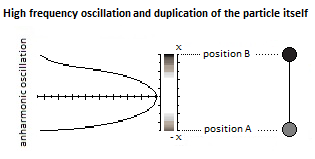 Figure 2.
Figure 2.
*I Duplication- of the particle itself.1.1. Background
1.2. Harmonic Oscillator vs Anharmonic Oscillator

Figure 3. 
Harmonic Oscillator vs Anharmonic Oscillator. Indeed thepth of the gravitational sin difference is made here and is between the ideal harmonic layout and the absolut anharmonic layout of the energy potential well. In the case of singularity avoidance due to the high Kinetic Energy of the particle, the plot of the curve of the potential well tends towards a harmonic shape rather than an anharmonic one. Moreover the anharmonic implication can be double: the variation of speed of the particle followed by the shape of the potential well due to the singularity, because t can involve this anharmonicity plus morse. In the following illustration, the integration of the singularity at x=0 is not yet represented.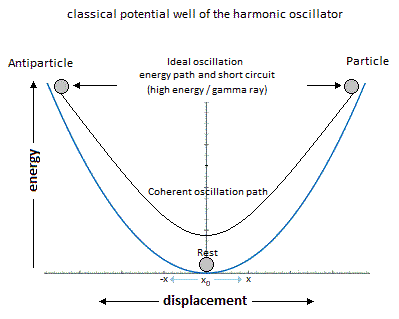



2. GPeravitationapetual Oscillatorion & Ideal Distribution of Energies
2.1. Gravitational Oscillator

 Figure 5. Gravitational oscillator and energy conservation between kinetic energy and potential energy SHO.
Figure 5. Gravitational oscillator and energy conservation between kinetic energy and potential energy SHO.3. Kinetic Energy & Potential Energy

2.2. Kinetic Energy & Potential Energy
 Figure 6. Oscillation cycle and alternation of Kinetic Energy and Potential Energy.
Figure 6. Oscillation cycle and alternation of Kinetic Energy and Potential Energy.2.3. Energy Path in the Potential Well
 Figure 7. Potential well and energy path.
Figure 7. Potential well and energy path.34. Source of Qquantum Ffluctuations & Ggravitational Ssingularity
3.1. Speculative Singularity
4. Singularity Avoidance & Higgs Boson
III - Singularity avoidance
4.1. Singularity Avoidance
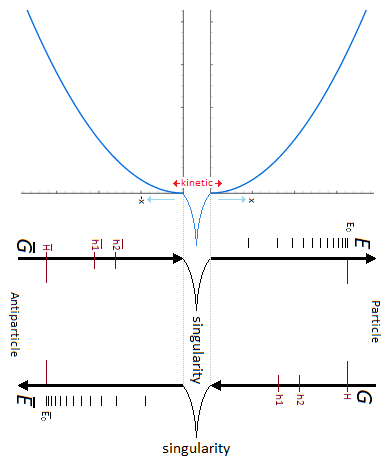
Higgs field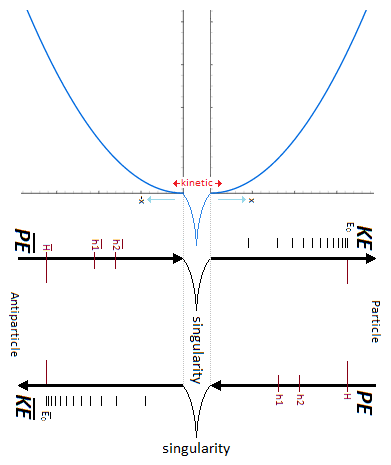 Figure 8. Gravitational oscillator and singularity avoidance by high kinetic of the particle.
Figure 8. Gravitational oscillator and singularity avoidance by high kinetic of the particle.4.2. Singularity Avoidance through Higgs Boson
 Figure 9. Gravitational oscillator and singularity avoidance through Higgs filed.
Figure 9. Gravitational oscillator and singularity avoidance through Higgs filed. Figure 10. Potential Energy in relation to the depth of the gravitational singularity and the Higgs potential.
Figure 10. Potential Energy in relation to the depth of the gravitational singularity and the Higgs potential.5. Second interpretation of singularity avoidance
5

6. Orbit, Iinertia, ZPE & Ppotential Bbarrier5.1. Potential Barrier by the Massive Object
 Figure 11. Singularity avoidance by inertia and orbit path (geodesic).
Figure 11. Singularity avoidance by inertia and orbit path (geodesic).5.1. Potential Barrier by the Particle Motion
5.2. The Zero Point Energy
67. Vacuum Mmetastability
6.1. Vacuum Metastability

6.2. Tunnel Effect
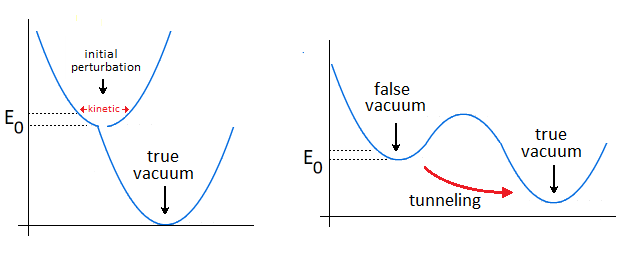
6.3. Bifurcation & Energy Dissociation
 Figure 14. Bifurcation & Energy Dissociation by upper Potential Well & Internuclear Distance & Morse Potential & Ionic Bond.
Figure 14. Bifurcation & Energy Dissociation by upper Potential Well & Internuclear Distance & Morse Potential & Ionic Bond.
7. Second Interpretation of Singularity Avoidance
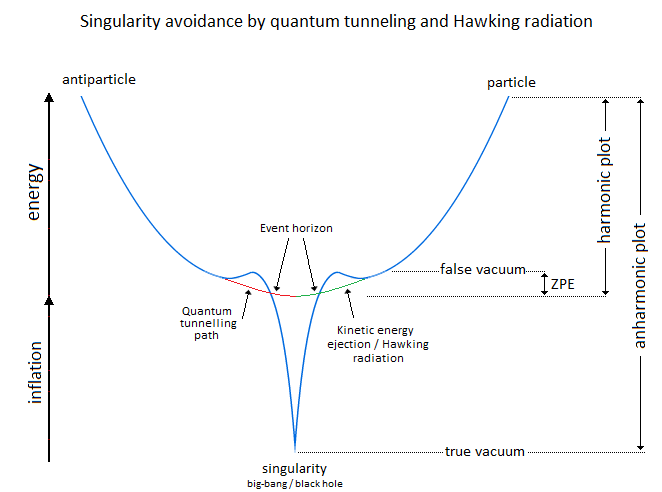
8. Graviton & Potential Energy

 Figure 17. Relationship between number of gravitons in relation to the Potential Energy.
Figure 17. Relationship between number of gravitons in relation to the Potential Energy.IV - Asymmetry CP matter antimatter
9. Asymmetry Matter Antimatter
109. Symmetry Bbreaking CP & Aarrow of Ttime T

10. Path of the particle, quantum fluctuation & Dark matter

11. Scalar & Vector Interpretation of the Particle
11.1. Invariant Transformation
 Figure 19. Anharmonic oscillation & probability of the Particle by scalar densiy.
Figure 19. Anharmonic oscillation & probability of the Particle by scalar densiy.
 Figure 20. Scalar representation of the energy according to the position of the particle.
Figure 20. Scalar representation of the energy according to the position of the particle. Figure 21.
Figure 21.11.2. Cosmic Inflation & Stress Energy Tensor

12. Path of the Particle, Quantum Fluctuation & Dark Matter
 Figure 23. Absolute path taken by the particle through the oscillation.
Figure 23. Absolute path taken by the particle through the oscillation.
113. Dark Eenergy
V - Atomic structure
142. Quantum Ssuperposition
 Figure 25. Combination of quantum superposition states.
Figure 25. Combination of quantum superposition states.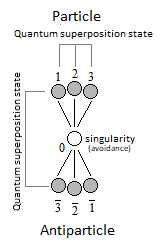
153. Quantum ChromoDynamics15.1. Coupling Constant & Asymptotic Freedom

15.2. Gluon & Quark

164. Particle Rradiation & Bboson

 Figure 28. Fermionic radiation and Bosonic radiation.
Figure 28. Fermionic radiation and Bosonic radiation.16.1. Stimulated Emission & Boson Emission
 Figure 29. Stimulated emission and photon emission in relation to its orbitals.
Figure 29. Stimulated emission and photon emission in relation to its orbitals.175. Atom & Qquantum Aatom
Pure quantum atom. The atomic mopure quantum atom is non-isotropic. It corresponds to the two choices which is that of the neutron N or the proton P. The reiteration in a series of Neutrons N followed by Protons P (same number of N as of P) is a pure atom. The atomic model described inhere Figure 30 represents the synopsis of the logical sequence of the oscillation mechanism of tha single moving particle through to. Here is the diagram of the anharmonic characteristic of the particle. Its oscillation is located between matter and antimatter, where between two its acceleration would then be almost instantaneous by singularity avoidance. We can see by the anharmonic oscillator the classic version of the internuclear distance followed by the morse potentials to be able to give the energy wanted to the particle. Figure 30. The anharmonic characteristic of the oscillator by the internuclear distance follow by the morse potential, makes it possible to give by the quantity of kinetic energy received from the particle its mass in term of electron-volt.
Figure 30. The anharmonic characteristic of the oscillator by the internuclear distance follow by the morse potential, makes it possible to give by the quantity of kinetic energy received from the particle its mass in term of electron-volt.

Thanks to the principle of reiteration, and if you had the choice between neutron and proton, the probability of finding an N neutron followed by a P proton like NP or NPN in the atomic nuclei is substantial. Which brings us, and in relation to the atomic signature, to the conclusion of a composition rich in Deuterium, Tritium and Helium 4-5-6 (Figure 33, Figure 34, Figure 35).





18. Example Structures & Conclusion
18.1. Example Structures
 Figure 36. Reiteration by oscillation of the particle in its position in several places.
Figure 36. Reiteration by oscillation of the particle in its position in several places.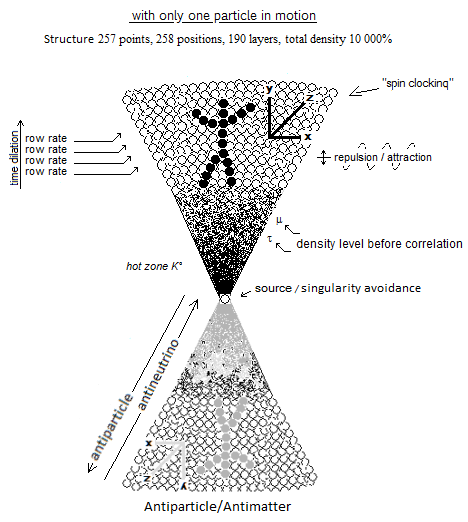 Figure 37. Example structure of the oscillation of the single particle. The field that guides the particle is responsible for the elements known.
Figure 37. Example structure of the oscillation of the single particle. The field that guides the particle is responsible for the elements known. Figure 38. Anharmonic Oscillator and the evolution of the universe.
Figure 38. Anharmonic Oscillator and the evolution of the universe.18.2. Simulation by Programming
18.3. Virtual Particles
18.4. Conclusion
VI - Example structure & conclusion

